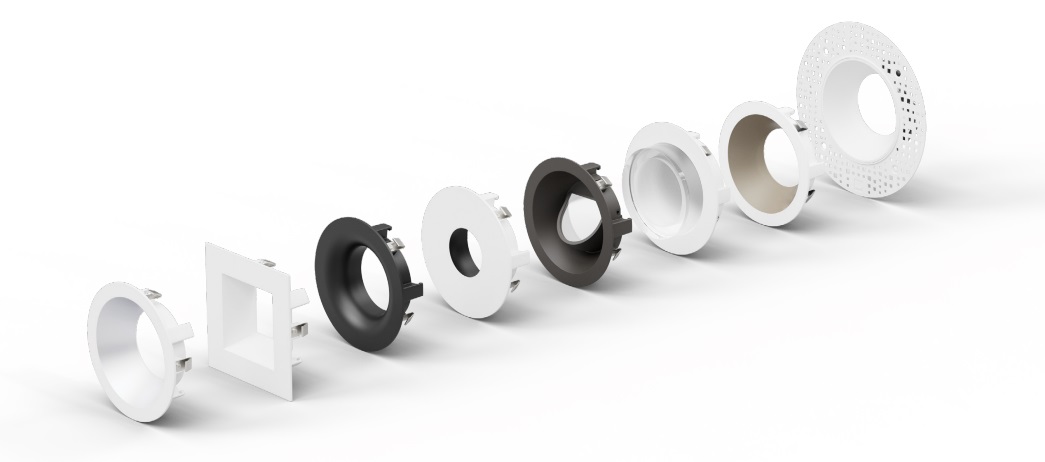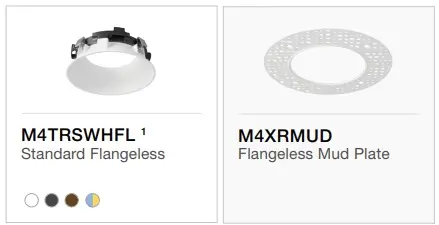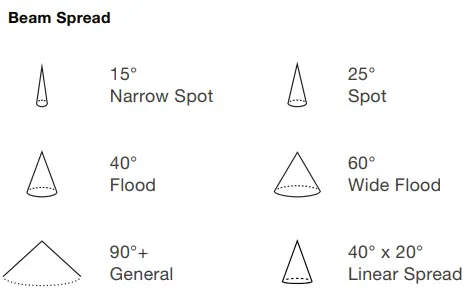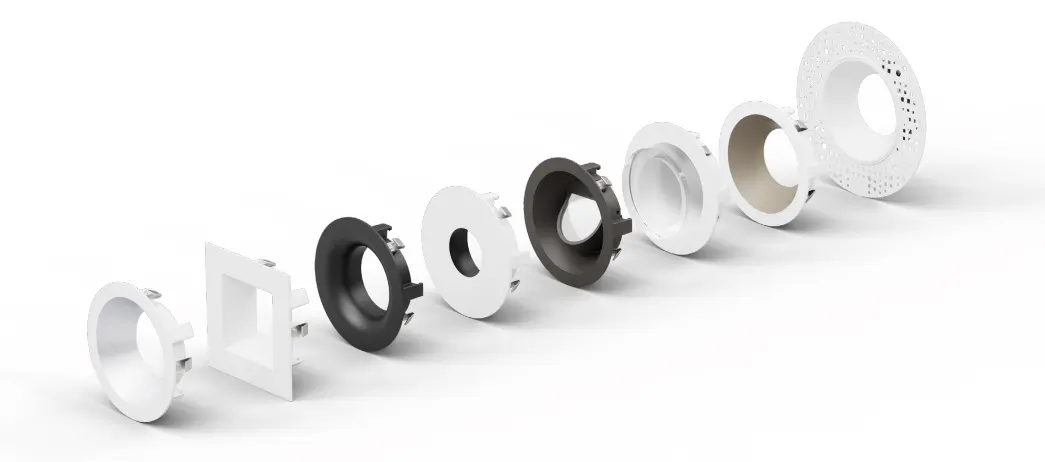Lighting
DMF Artafex Compared to H-Series Downlights
DMF Artafex & H-Series Compared
What’s the difference between DMF Artafex and H-Series downlights? How do they compare to builder’s grade can trims?
The Artafex line is DMF’s premium downlight, available by dealer only. It competes with premium products from other high end fixture companies.
The DMF H-Series competes against builder’s grade trims, is slightly higher priced, but has a couple premium features that make it an easy choice against traditional options.
Style Options:
DMF has the Artafex available in both a 4″ and a 2″ option. The H-series is available in 4″ and 3″.
The H-Series has 4 available trims options, each available in either white or black. These options include a round recessed trim, a round flush trim, a square recessed trim, and an adjustable trim.

The Artafex 4″ has approximately 11 different trim options available in either white, black, bronze, or custom colors. This includes fixed wall wash trims, pinhole trims, hyperbolics, and adjustable versions of each. The true number of options is close to 75 if you do not include custom colors.

Only the Artafex 4″ and 2″ downlights include an option for a flangeless trim. This is similar to a standard round trim, but instead of a trim lip that overalps the drywall, the trim is installed within a mud flange. The mud flange allows the drywaller to finish the drywall surface directly up to the trim. The ceiling will seamless transition from drywall to white metal trim, leaving only the 1/8″ lip of the trim exposes, flush with the ceiling surface. This is the most modern, elegant, and intentional style available.

Warm Dimming & Color Tempurature:
Warm dimming, also called Dim to Warm, is when a light has a variable color tempurature depending on it’s brightness. When the light is at 100% brightness, it might be at soft-warm color tempurature, approximately 3000K. Then, as it is dimmed, the color tempurature gets warmer, from soft-white, to yellow, to yellow/orange/red, such that when it reaches 1% brightness it may be at a color temperature of 1800K.
The reason warm dimming is desireable is because it closely mimics the color profiles of traditional incandescant lighting, which were always beautiful when dimmed. Traditional CCT can trims with a fixed color tempurature actually get more white/blue as they dim, which does not give a dim room a cozy feeling. In fact.
Warm light promotes feelings of relaxation and rest because it is more like natural sunset, where as white/blue light may promote awakeness as it is closer to daylight. Warm dimming provides the whitest light at full brightness and the warmest, fiery light when it is most dim.
When you measure warm dimming, it’s generally within a range, the highestt number being the color temperature at full bright, and the lowest number being the color tempurature at most dim.
The H-Series is only available in Warm Dim (Dim to Warm). There are two range options available, 3000K-2200K or 2700K-1800K.
The Warm dim range of the Artafex is 3000K-1800K, so that is starts outa the perfect soft-white and dims into the warmest orange/red. This is the ideal dimming curve, so it is the only option available.
The typical flaw of warm dimming is that as the light gets more warm it either steps the color tempurature down in increments that are too large to be smooth and natural, or that it sacrifices the actual quality of the light. The Artafex series solves this with their proprietary TrueSpectrum technology that makes the dimming curve super smooth as it warms, and keeps the light output at 93+ CRI throughout the entire range.
To sum up the differences in warm dimming, the Artafex has the wideset, most ideal warm dimming curve, whereas the H-Series you have to choose a curve that is either more yellow when full bright, or more warm when full dim. The Artafex also maintains a higher color accuracy, and smoother color tempurature stepping throughout the range.
Traditional builders trims typically do not match the range of even the H-Series, and usually provided a more coarsely stepped curve as it works it’s way to warm.
Color Tempurature & Brightness:
DMF Artafex is also available in static color temperatures, for loads that will not be dimmed, or when a specific color tempurature is desired throught the dimming range. These options include 2700K, 3000K, 3500K, and 4000K.
The Artafex warm dimming option is only available with a 1000 lumen (brightness) output, but the static color temperatures are available with up to a 1500 lumen output.
To put this into perspective, most 4″ and 6″ builders grade trims have a 750 lumen output. The H-series has a 950 lumen output, and the Artafex is 1000-1500 lumens depending on the color tempurature profile.
Higher lumen output means you can put less lights in the ceiling and still have the same brightness to floor or work surface. Less lights in the ceiling provides a more elegant and modern look, and may cost less as well. Add that the fact that these are smaller than triditional builders trims, and the ceilings become much, much quieter. When using the Artafex Flangless options, the ceiling might as well be silent, it is a beautiful result.
Available Optics:
The H-Series module come with a lens (diffuser) on the front that provides general ambient light, meaning that it scatters the light at more than 90 degrees. This is typical, even for builder’s grade trims.
The Artafex series has 7 different optics available for their downlight modules. The optics can also be field swapped in less than 20 seconds, and they are inexpensive.
A more focused optic, with a more narrow dispersion angle, will provide brighter light to a more specific area, and less light around it. Specialty optics are great for highlight artwork, custom cabinetry, or for providing task lighting to surfaces, such as kitchen counters, desks, etc.
There are 7 optics to choose from, available in both 2″, 4″, and for the adjustable versions of each.

Color Rendering Quality:
Color rendering quality is measured in CRI. A CRI of 100 would represent the color accuracy of light reflected from an object in natural sunlight, on a clear day.
In real life, this simply means that objects under this light will appear more natural and beautiful. For example, using a poor quality LED flashlight will make everything you shine it on look blue. This is because it has a terribly low CRI, because the light that it puts out only includes part of the color spectrum.
Similarly, there’s the grocery store test. Take a Zucchini in from the produce section in a high end grocery store and examine it under the light. Find one that looks particularly good. Then, take that same Zucchini into the cereal aisle and look at it again. It will look a lot less disireable. This is because the grocery paid for lighting with higher CRI in the produce section, while the general lighting the rest of the store is only high enough quality to read boxes, labels, and price tags.
This translates, in your home, to your cabinetry, art work, and furniture looking more beautiful. For all that money spent on custom cabinets, they should be lit with the best light available. Higher CRI also produces the best pictures.
CRI is based on laboratory color rendering of 8 sample colors, and how well they are reproduced.
Typical builders trims are between 80-90 CRI. The DMF H-Series is 90+ CRI, and the Artafex series is 93+ CRI.
DMF also introduced True Spectrum technology into their Artafex series, which further increaeses the color quality. True Spectrum uses 99 color samples instead of the traditional 8 colors. Read more about True Spectrum here.
Dimming & Control System Compatibility:
DMF has tested compatibility with major lighting control systems such as Lutron Radio RA3, Lutron Homeworks, and Vantage.
Artafex series drivers are “dim to dark” where they can dim all the way to 1% preceived brightness before they shut off. H-Series will dim to 5%. Most traditional builders trims are in the 10% range.
A common problem with traditional builder’s grade trims is that each LED may come on at a different minimum brightness. If there’s a switch leg of 8 lights, 1 may come on slightly before the rest, or 1 may linger off while the rest are on, in the case that the brightness is being slowly ramped from 1% to 100%. This is called the popcorn effect, and is a common problem in Lutron or Vantage lighting systems because of the natural ramping they provide when switch legs are turned on/off.
DMF is so confident in the Artafex series compatibility, that if you have any problem with any major lighting control system, they will simply give your money back.
The internals of the Artafex series are the best compatibility for higher end lighting control systems, with the H-Series being a reasonable second.
Warranty:
Traditional LED trims typically have a 1 year warranty. H-Series modules have a 5 year warranty. Artafex series has a 10 year warranty.
This is important when considering the cost of the driver. Builders grade trims may only last a few years, meaning, you will have a replacement cost at some point, maybe at multiple points throughout ownership.
H-Series modules significantly reduce this risk by providing a 5 year warranty.
Artafex series drivers provide a 10 year warranty, so althogh the cost is much higher, it is gaurunteed no replacement necessary for at least 10 years.

